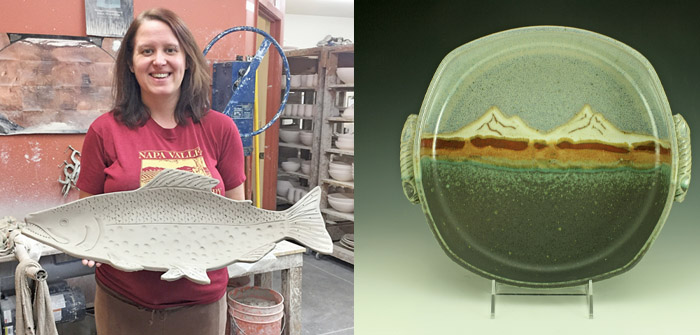((Left) Melissa Woodman. Photo courtesy of Red Chair Gallery (Right) Blue Spruce baking dish by Patrick Woodman)
When a new generation takes over a family-owned business, there is usually an orderly transition. In the case of Blue Spruce Pottery, the changeover was completely unexpected, due to the death of founder Michael Gwinup one year ago. Gwinup, who started the business with his wife Michele in 1976, died suddenly while snowboarding at Mt. Bachelor. Daughter and son-in-law Melissa and Patrick Woodman were thrown abruptly into a steep learning curve to run the business.
“Dad never wrote anything down,” says Melissa, “so we had to figure a lot of things out.” The Woodmans had worked at the pottery for several years but had never managed a business. Over the years, Michael perfected and even invented many processes, but rarely documented them.
The first action they took was to shut down everything for a month to grieve and regroup. They paused the Blue Spruce website while they analyzed the work that needed to be done. Although Michele still does the bookkeeping and ordering of supplies, the Woodmans are responsible for most of the production and operation. Caring for their two children, ages three and six, takes a good deal of time as well.
With two people doing the work of three, the Woodmans decided to drop their wholesale business. The volume of product needed for wholesale was more than they could produce and it was not as profitable as retail. “We knew what we had to do because we were already doing a lot of the work,” Melissa recalls. “This is our career and not a hobby. It was more like how do we move forward.” Blue Spruce is well-known for its line of stoneware, featuring iconic scenes of Central Oregon mountains, and that is where the Woodmans concentrated. Before he died, Michael mostly had been making raku pieces and this part of the business was put on the back burner.
Getting all the undocumented techniques worked out for the stoneware was often difficult. For example, Melissa needed to figure out how to make a particular glaze, which required pine ash. To make it, you pour the pine ash powder into a bucket of water and wash it many times to reduce the acidity. But exactly how many times was a secret Michael seemed to have kept to himself. Melissa didn’t know whether to wash the ash powder 10 times or 15 times, and sometimes the required washings varied depending on the purity of the ash. Finally, she found some hache marks on the kiln that indicated the recommended number of washings. “He left clues but you had to know where to look for them,” Melissa laughs.
For the kiln operation, Michael wrote out one page of instructions which were not very exact. One step requires you to open the dampener to control the amount of air coming in. Michael had written: “Pull it out to the invisible line.” The Woodmans eventually figured out where the imperceptible mark was, but “the invisible line became a joke,” Melissa chuckles. Sometimes, the Woodmans had to search their memories for the little tips and techniques Michael related in conversations. Except for his glaze recipes, which were very exact, “he just winged it most of the time,” Melissa says.
Now the kiln operation, as well as other processes and techniques are fully documented but the work still requires many more hours than an ordinary job. When Patrick fires up the kiln, he has to stay there for the 10 hours it runs, while Melissa takes care of the children. Keeping up with website and gallery orders has limited the Woodmans’ time for creativity. Melissa wants to rekindle the raku business but is trying to find her own style rather than replicate her father’s. Ramping up raku lamp production has also been hampered by supply chain issues, such as finding the electrical parts needed. Many customers are on the waiting list for the lamps.
Despite the somewhat rocky transition and growing pains, Blue Spruce continues to thrive and undoubtedly will surprise us with new designs in the near future. Blue Spruce Pottery is showcased at Red Chair Gallery in March.

